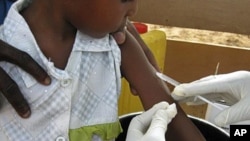Efforts are underway to speed vaccine development and delivery in 72 countries over the next 10 years. New studies say that would save the lives of more than six million children and save billions of dollars. But advocates say poor countries may not be able to pay for the expanded immunization on their own. As a result, health related groups are calling for greater international investment.
The World Health Organization estimates nearly two and a half million children die every year because they have not been vaccinated against preventable diseases.
Two new studies published in the June issue of the journal Health Affairs say that doesn’t have to happen. They report on the effects of vaccinating 90 percent of children in more than 70 countries. The vaccines would target pneumococcal pneumonia, diphtheria, pertussis or whooping cough, tetanus, measles, rotavirus, malaria and Haemophilus influenza type B, also known as Hib disease, which is a brain infection.
“Every day, millions of children die needlessly, and for relatively small amounts of money we can save those lives. If you consider that saving six million lives over a decade is like saving the population of Ireland just with vaccinations, it’s pretty obvious to see that this is an incredible opportunity,” said Dr. Orin Levine, executive director of the International Vaccine Access Center at Johns Hopkins Bloomberg School of Public Health.
Good return on investment
“We’re estimating that over the next 10 years, while saving six million children’s lives, we can also generate savings or economic value of between150 and 230 billion dollars,” he said.
For example, healthy children mean families are not burdened with medical costs. And that can keep them out of poverty.
While two new studies promote the benefits of childhood immunization, a third study, by the GAVI Alliance and Results for Development Institute, says, “Poor countries will be hard pressed to pay for expanded vaccine delivery without substantial outside support.”
“What we have,” said Levine, “is a shortfall over the next several years of about $4 billion. And next week in London, international governments will be sitting together to make pledges to help fill that funding shortfall. When people hear $4 billion they think that this is a huge number and in many ways it is. But realize that essentially for the price of a latte coffee you can buy a dose of a life saving vaccine. This is really within the reach of everyday citizens and their governments.”
Researchers say low-income countries could pay a “modest share” of the cost, about 20 cents per dose.
Making diseases disappear
Dr. Levine says he believes it’s possible to eliminate many childhood diseases in developing countries.
“I say this from personal experience. We’ve seen it here in the United States. If you talk to pediatricians who are about 45 or older, they will tell you we used to see children with bacterial meningitis due to Hib and pneumococcus all the time. And now that we’ve been using these vaccines in this country we basically never see them,” he said.
In recent days there has been encouraging news about vaccine prices. Vaccine makers announced they are cutting the price by as much as 60 percent in some cases.
Levine says it’s some of the best news regarding vaccines in the last 10 years.














